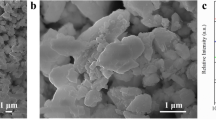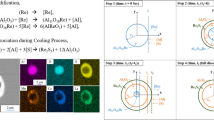Abstract
The so-called CALPHAD method is widely used in metallurgy to predict phase diagrams of multi-component systems. The application of the method to oxide systems is much more recent, mainly because of the difficulty of modelling the ionic liquid phase. Since the 1980s, several models have been proposed by various communities. Thermodynamic databases for oxides are available and still under development. The purpose of this article is to discuss the distinct approaches of the method for the calculation of multi-component systems for Portland cement elaboration. The article gives a state of the art of the most recent experimental data and the various calculations for the CaO–Al2O3–SiO2 phase diagram. A literature review of the three binary sub-systems leads to main conclusions: (i) discrepancies are found in the literature for the selected experimental data, (ii) the phase diagram data in the reference books are not complete and up to date and (iii) the two-sublattices model and the modified quasichemical model can be equally used for the modelling of the aluminates liquid. The predictive feature of the CALPHAD method is illustrated using the CaO–Al2O3–SiO2 system with the two-sublattices model: extrapolated (predicted) and fully-assessed phase diagrams are compared in the clinkering zone of interest. The recent application of the predictive method for the calculations of high-order systems (taking into account Fe2O3, SO3, CaF2, P2O5,…) shows that the databases developed with the two-sublattices model and the modified quasichemical model are no longer equivalent.






Similar content being viewed by others
Notes
The triangular symbol in the left-hand corner of the diagrams indicates that the figure has been calculated with the Thermo-Calc software. The condensed oxide notation is used for the defined compounds, excepted for the CaO, SiO2 and Al2O3 components.
Note that Rankin firstly assigned the C12A7 phase to C5A3.
References
Rankin GA, Wright FE (1915) Am J Sci 39:1
Lea F (1998) Lea’s chemistry of cement and concrete, 4th edn. P.C. Hewlett, London
Taylor HFW (1997) Cement chemistry, 2nd edn. Thomas Telford Edition, London
Butt YM, Timashev VV (1974) 6th international congress on the chemistry of cement, Moscow, September 1974, p 2
Timashev VV (1980) 7th international congress on the chemistry of cement, Paris, p 1
Maki I, Goto K (1982) Cem Concr Res 12:301
de Noirfontaine M-N, Tusseau-Nenez S, Signes-Frehel M, Gasecki G, Girod-Labianca C (2009) J Am Ceram Soc 92(10):2337
Saunders N, Miodownik AP (1998) CALPHAD (calculation of the phase diagrams): a comprehensive guide. Pergamon Materials Series, Oxford
Lukas HL, Fries SG, Sundman B (2007) Computational thermodynamics. The Calphad method. Cambridge University Press, New York
Special issue of Calphad J 19(4):433 (1995)
Hillert M (1980) Calphad 4(1):1
Muggianu Y-M, Gambino M, Bros J-P (1975) J Chim Phys 72:83
Pelton AD, Blander M (1986) Metall Trans B 17:805
Hillert M, Jansson B, Sundman B, Agren J (1985) Metall Trans A 16:261
Sundman B (1991) Calphad 15(2):109
Sommer F (1982) Z Metallkd 73(2):72
Gaye H, Welfringer J (1984) 2nd international symposium, Warrendale, p 357
Barry TI, Glasser FP (2000) Adv Cem Res 12(1):19
Decterov SA, Kang Y-B, Jung I-H (2009) J Phase Equilib Diffus 30(5):443
Kattner UR, Handwerker CA (2001) Z Metallkd 92(7):740
Levin EM, Robbins CR, McMurdie HF (1964) Phase diagrams for ceramists. The American Ceramic Society, Columbus, OH
Yamada T, Yoshimura M, Somiya S (1986) J Am Ceram Soc 69(10):C243
Levin EM, McMurdie HF (1975) Phase diagrams for ceramists 1975 supplement. The American Ceramic Society, Columbus, OH
Tewhey JD, Hess PC (1979) Phys Chem Glasses 20(3):41
Hageman VBM, Van den Berg GJK, Janssen HJ, Oonk HAJ (1986) Phys Chem Glasses 27(2):100
Hillert M, Sundman B, Wang X (1990) Metall Trans B 21:303
Hillert M, Sundman B, Wang X (1991) Calphad 15(1):53
Huang WL, Hillert M, Wang X (1995) Metall Trans A 26:2293
Tromel G, Fix W, Heinke R (1969) Hochtemperaturuntersuchungen bis 1900 °C an Calciumorthosilikat und Tricalciumsilikat Tonindustrie-Zeitung 93-1:1
Elliott JF, Gleiser M (1960) Thermochemistry for steelmaking. Addison-Wesley, Reading, MA
Eriksson G, Wu P, Blander M, Pelton AD (1994) Can Metall Q 33(1):13
Somiya S. Tokyo Inst. Technology, Yokahama, unpublished work
Taylor JR, Dinsdale AT (1990) Calphad 14(1):71
Ball RGJ, Mignanelli MA, Barry TI, Gisby JA (1993) J Nucl Mater 201:238
Zaitsev AI, Zemchenko M, Litvina AD, Mogutnov BM (1993) J Mater Chem 3(5):541
Nurse RW, Welch JH, Majumdar AJ (1965) Trans J Br Ceram Soc 64:409
Nityanand N, Fine HA (1983) Metall Mater Trans B 14(4):685
Nurse RW, Welch JH, Majumdar AJ (1965) Trans J Br Ceram Soc 64:323
Muan A, Osborn EF (1965) Phase equilibria among oxides in steel-making. Addison-Wesley, Reading, MA
Chatterjee AK, Zhmoidin GI (1972) J Mater Sci 7:93. doi:10.1007/BF00549555
Rolin M, Thanh PH (1965) Revue des Hautes Températures et Réfractaires 2:175
Hallstedt B (1990) J Am Ceram Soc 73(1):15
Mao H, Selleby M, Sundman B (2004) Calphad 28:307
Eriksson G, Pelton AD (1993) Metall Trans B 24:807
Aramaki S, Roy R (1962) J Am Ceram Soc 45(5):229
Bowen NL, Greig JW (1924) J Am Ceram Soc 7(4):238
Aksay IA, Pask JA (1975) J Am Ceram Soc 58(11–12):507
Davis RF, Pask JA (1972) J Am Ceram Soc 55(10):525
Konopicky K (1956) Bulletin de la Société française de Céramiques 33:3
Toropov NA, Galakhov FY (1951) Doklady Akademii Nauk SSSR 78(2):299
Klug FJ, Prochazka S, Doremus RH (1987) J Am Ceram Soc 70(10):750
Hamano K, Sato T, Nakagawa Z (1986) Yogyo-Kyokai-Shi 94(8):818
Okada K, Otsuka N (1987) J Am Ceram Soc 70(10):C245
Prochazka S, Klug FJ (1983) J Am Ceram Soc 66(12):874
Mao H, Selleby M, Sundman B (2005) J Am Ceram Soc 88(9):2544
Risbud SH, Pask JA (1978) J Am Ceram Soc 61(1–2):63
Horibe T, Kuwabara S (1967) Bull Chem Soc Jpn 40(4):972
Staronka A, Pham H, Rolin M (1968) Revue Internationale des Hautes Températures et des Réfractaires 5:111
Fabrichnaya OB, Costa e Silva A, Aldinger F (2004) Z Metallkd 95(9):793
Welch JH (1960) Nature 186:545
Yazhenskikh E, Hack K, Müller M (2008) Calphad 32:195
Mao H, Hillert M, Selleby M, Sundman B (2006) J Am Ceram Soc 89(1):298
Pelton AD (2005) Miner Process Extract Metall (Trans Inst Min Metall C) 114:C172
Andersson JO, Helander T, Hoglund L, Shi P, Sundman B (2002) Calphad 26(2):273
Roth RS, Dennis JR, McMurdie HF, Clevinger MA, Ondik HM, Schenk PK (1987) Phase diagrams for ceramists. The American Ceramic Society, Westerville, OH
Schairer JF, Bowen NL (1955) Am J Sci 253:681
Hillert M, Selleby M, Sundman B (1990) Metall Trans A 21:1990
Fabrichnaya OB, Sundman B (1997) Geochim Cosmochim Acta 61(21):4539
Decterov SA, Jung IH, Jak E, Kang YB, Hayes P, Pelton AD (2004) VII international conference on molten slags fluxes and salts. The South African Institute of Mining and Metallurgy, p 839
Hallstedt B (1995) J Am Ceram Soc 78(1):193
Mao H, Fabrichnaya OB, Selleby M, Sundman B (2005) J Mater Res 20(4):975
Jung IH, Decterov SA, Pelton AD (2004) J Phase Equilib Diffus 25(4):329
Jung IH, Decterov SA, Pelton AD (2005) J Eur Ceram Soc 25:313
Acknowledgements
CTG-Italcementi Group financially supported this study, within the research collaboration framework between the CECM (CNRS, France) and CTG (Italcementi Group, France) laboratories. The authors acknowledge B. Bollotte, E. Moudilou and F. Amin (CTG) for valuable discussions. Many thanks to G. Inden, Bo Sundman, J.-M. Joubert and P. Chartrand for fruitful discussions about Calphad method, models and softwares. The authors also express their sincere thanks to H. Szwarc and R. Céolin for advice and are warmly thankful to F. Dunstetter for his critical reading of the manuscript.
Author information
Authors and Affiliations
Corresponding author
Rights and permissions
About this article
Cite this article
de Noirfontaine, MN., Tusseau-Nenez, S., Girod-Labianca, C. et al. CALPHAD formalism for Portland clinker: thermodynamic models and databases. J Mater Sci 47, 1471–1479 (2012). https://doi.org/10.1007/s10853-011-5932-7
Received:
Accepted:
Published:
Issue Date:
DOI: https://doi.org/10.1007/s10853-011-5932-7




